2022 HYUNDAI KONA wheel
[x] Cancel search: wheelPage 14 of 579
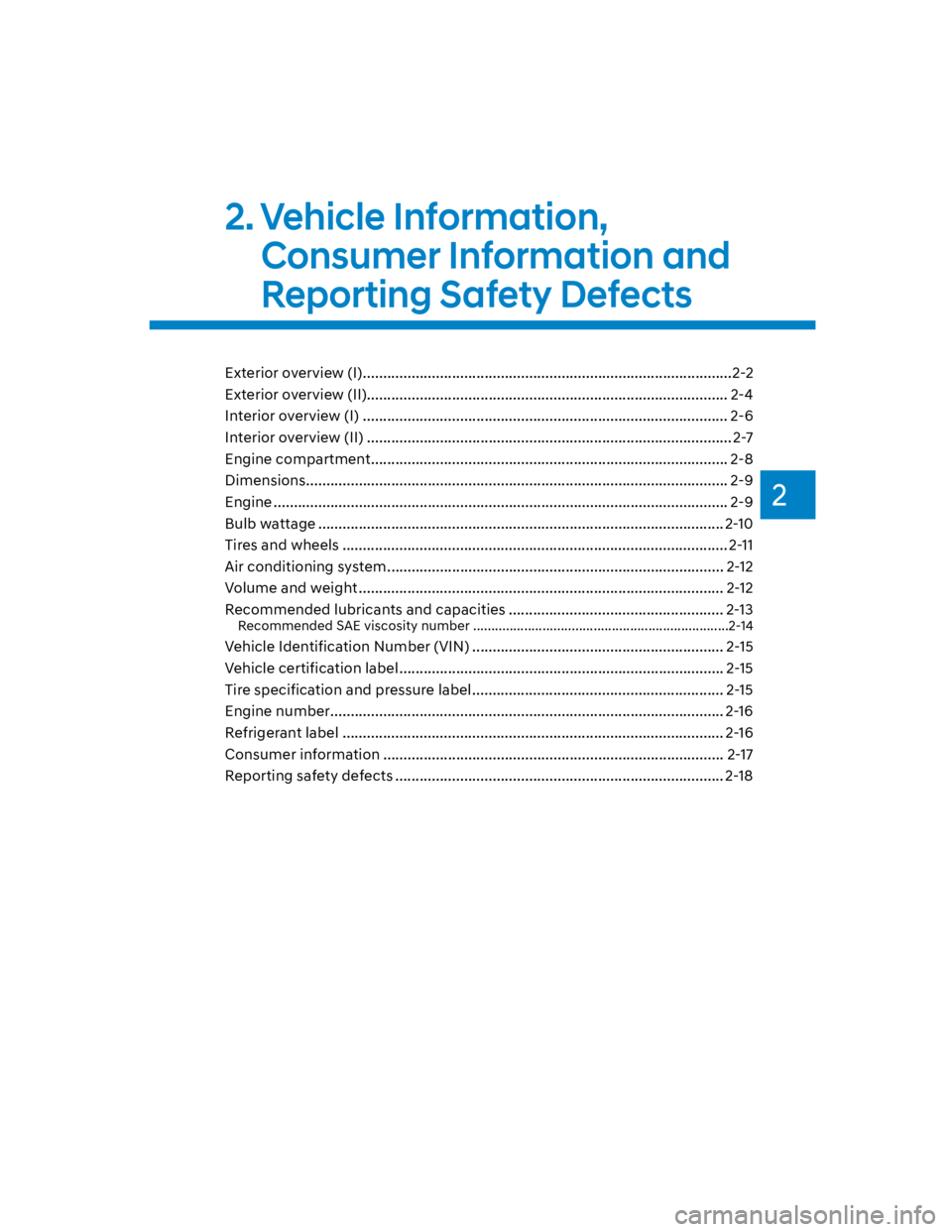
2
2. Vehicle Information,
Consumer Information and
Reporting Safety Defects
Exterior overview (I) ...........................................................................................2-2
Exterior overview (II) ......................................................................................... 2-4
Interior overview (I) .......................................................................................... 2-6
Interior overview (II) .......................................................................................... 2-7
Engine compartment ........................................................................................ 2-8
Dimensions ........................................................................................................ 2-9
Engine ................................................................................................................ 2-9
Bulb wattage .................................................................................................... 2-10
Tires and wheels ............................................................................................... 2-11
Air conditioning system ................................................................................... 2-12
Volume and weight .......................................................................................... 2-12
Recommended lubricants and capacities ..................................................... 2-13
Recommended SAE viscosity number ......................................................................2-14
Vehicle Identification Number (VIN) .............................................................. 2-15
Vehicle certification label ................................................................................ 2-15
Tire specification and pressure label .............................................................. 2-15
Engine number ................................................................................................. 2-16
Refrigerant label .............................................................................................. 2-16
Consumer information .................................................................................... 2-17
Reporting safety defects ................................................................................. 2-18
Page 15 of 579

2-2
Vehicle Information, Consumer Information and Reporting Safety Defects
Front view
The actual shape may differ from the illustration.
OOS010001N
1. Hood ....................................................... 5-61
2. Head lamp ............................................. 9-59
3. DRL (Daytime Running Light) .............. 9-59
4. Turn signal lamp ................................... 9-59
5. Tires and wheels ................................... 9-33
6. Side view mirror .................................... 5-50
7. Sunroof ...................................................5-57
8. Front windshield wiper blades .............9-27
9. Windows ............................................... 5-53
Page 16 of 579
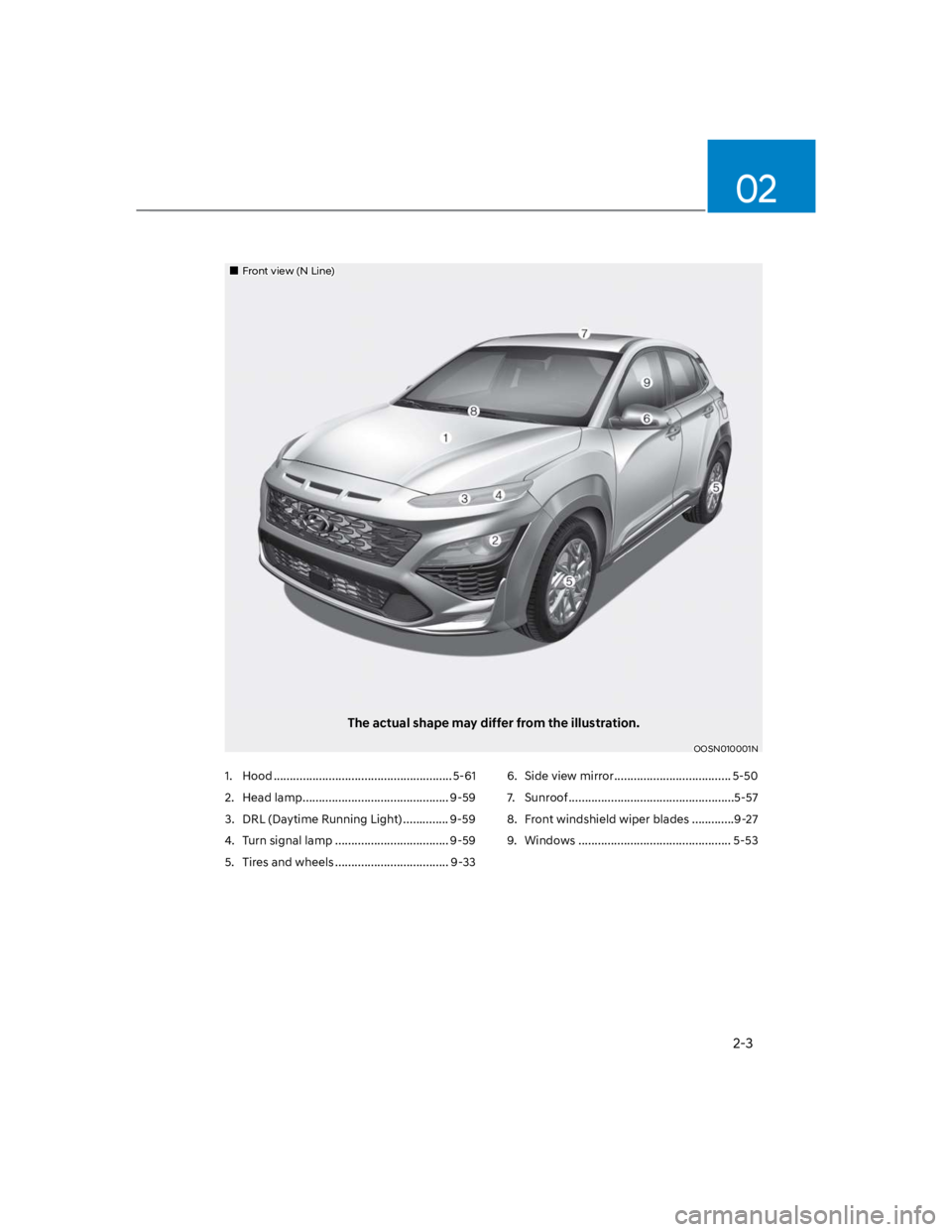
2-3
02
Front view (N Line)
The actual shape may differ from the illustration.
OOSN010001N
1. Hood ....................................................... 5-61
2. Head lamp ............................................. 9-59
3. DRL (Daytime Running Light) .............. 9-59
4. Turn signal lamp ................................... 9-59
5. Tires and wheels ................................... 9-33
6. Side view mirror .................................... 5-50
7. Sunroof ...................................................5-57
8. Front windshield wiper blades .............9-27
9. Windows ............................................... 5-53
Page 19 of 579
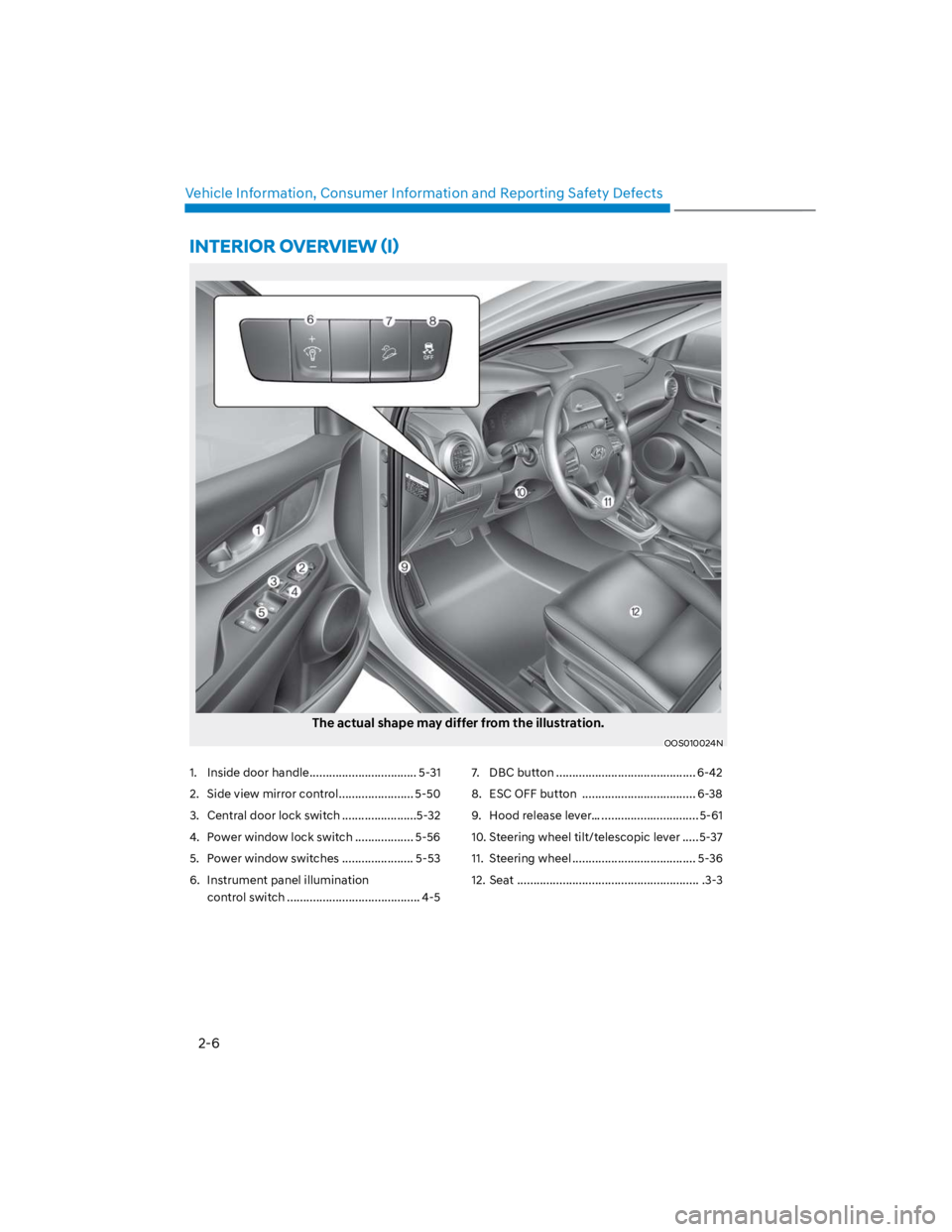
2-6
Vehicle Information, Consumer Information and Reporting Safety Defects
The actual shape may differ from the illustration.
OOS010024N
1. Inside door handle ................................. 5-31
2. Side view mirror control ....................... 5-50
3. Central door lock switch .......................5-32
4. Power window lock switch .................. 5-56
5. Power window switches ...................... 5-53
6. Instrument panel illumination
control switch ......................................... 4-5
7. DBC button ........................................... 6-42
8. ESC OFF button ................................... 6-38
9. Hood release lever… .............................. 5-61
10. Steering wheel tilt/telescopic lever .....5-37
11. Steering wheel ...................................... 5-36
12. Seat ........................................................ .3-3
Page 20 of 579

2-7
02
The actual shape may differ from the illustration.
OOS010004N
1. Instrument cluster .................................. 4-4
2. Horn ....................................................... 5-38
3. Driver’s front air bag ............................. 3-43
4. Engine Start/Stop button ....................... 6-8
5. Light control/Turn signals .................... 5-67
6. Wiper/Washer ........................................ 5-77
7. Infotainment system ............................5-116
8. Hazard warning flasher switch .............. 8-2
9. Manual climate control system ............5-81
Automatic climate control system ...... 5-89
10. Passenger’s front air bag ..................... 3-43
11. Glove box .............................................5-104
12. USB Charger........................................5-109
13. Power outlet .........................................5-108
14. Dual clutch transmission shift lever ..... 6-18
Intelligent variable transmission shift
lever ........................................................ 6-13
15. Drive mode button ...............................6-60
16. Heated steering wheel ......................... 5-38
17. Idle stop and go (ISG) OFF button ....... 6-54
18. Seat warmer/Air ventilation seat .......... 3-17
19. 4WD lock button ...................................6-46
20. Parking Safety button………….. .............. 7-113
21. Cup holder ........................................... 5-107
22. Steering wheel audio controls/ ........... 5-117
Bluetooth® wireless technology
hands-free controls ..............................5-118
23. Driving Assist button/ .......................... 7-65
Lane Driving Assist button/ ..................7-30
Vehicle Distance button ....................... 7-65
Page 22 of 579
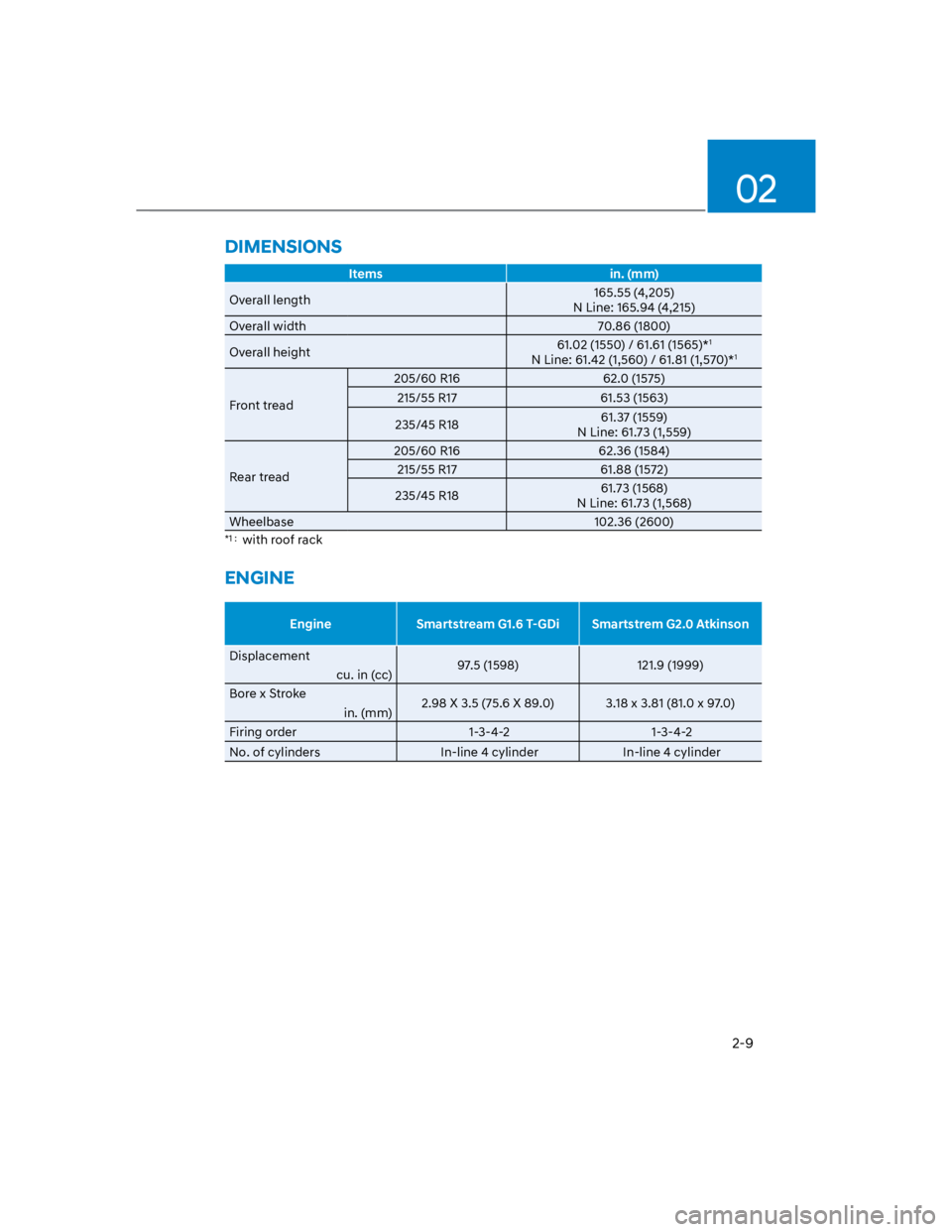
02
2-9
Items in. (mm)
Overall length165.55 (4,205)
N Line: 165.94 (4,215)
Overall width 70.86 (1800)
Overall height61.02 (1550) / 61.61 (1565)*1
N Line: 61.42 (1,560) / 61.81 (1,570)*1
Front tread
205/60 R16 62.0 (1575)
215/55 R17 61.53 (1563)
235/45 R1861.37 (1559)
N Line: 61.73 (1,559)
Rear tread
205/60 R16 62.36 (1584)
215/55 R17 61.88 (1572)
235/45 R1861.73 (1568)
N Line: 61.73 (1,568)
Wheelbase 102.36 (2600)
*1 : with roof rack
ENGINE
Engine Smartstream G1.6 T-GDi Smartstrem G2.0 Atkinson
Displacement
cu. in (cc)97.5 (1598) 121.9 (1999)
Bore x Stroke
in. (mm)2.98 X 3.5 (75.6 X 89.0) 3.18 x 3.81 (81.0 x 97.0)
Firing order 1-3-4-2 1-3-4-2
No. of cylinders In-line 4 cylinder In-line 4 cylinder
DIMENSIONS
Page 24 of 579
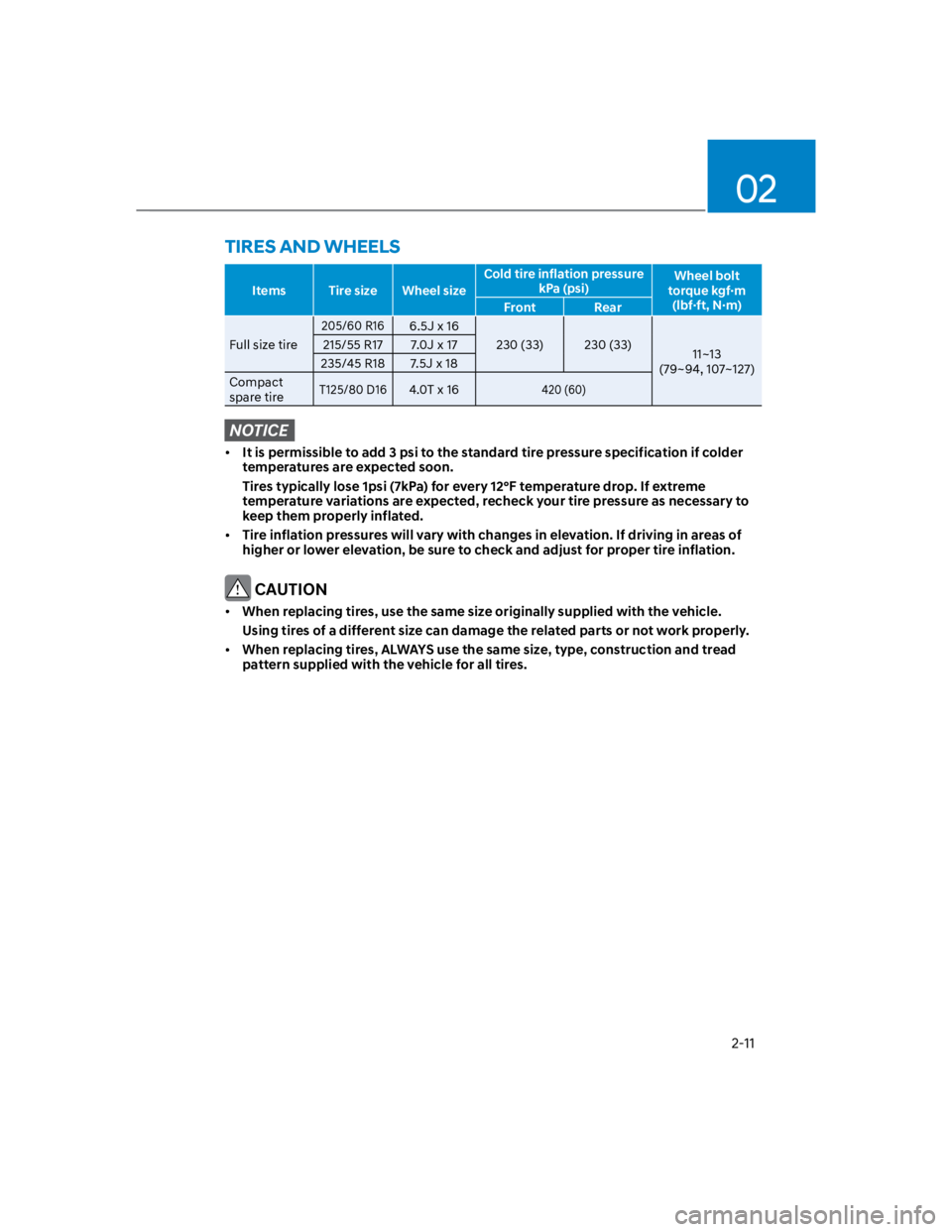
02
2-11
Items Tire size Wheel size
Cold tire inflation pressure
kPa (psi)
Wheel bolt
torque kgf·m
(lbf·ft, N·m)Front Rear
Full size tire
205/60 R16
6.5J x 16
230 (33) 230 (33)11~13
(79~94, 107~127)
215/55 R17 7.0J x 17
235/45 R18 7.5J x 18
Compact
spare tire
T125/80 D16
4.0T x 16
420 (60)
NOTICE
It is permissible to add 3 psi to the standard tire pressure specification if colder
temperatures are expected soon.
Tires typically lose 1psi (7kPa) for every 12°F temperature drop. If extreme
temperature variations are expected, recheck your tire pressure as necessary to
keep them properly inflated.
Tire inflation pressures will vary with changes in elevation. If driving in areas of
higher or lower elevation, be sure to check and adjust for proper tire inflation.
CAUTION
When replacing tires, use the same size originally supplied with the vehicle.
Using tires of a different size can damage the related parts or not work properly.
When replacing tires, ALWAYS use the same size, type, construction and tread
pattern supplied with the vehicle for all tires.
TIRES AND WHEELS
Page 33 of 579

Seats & Safety System
3-2
You will find many safety precautions
and recommendations throughout this
section, and throughout this manual.
The safety precautions in this section are
among the most important.
Always wear your seat belt
A seat belt is your best protection in all
types of accidents. Air bags are designed
to supplement seat belts, not to replace
them. So even though your vehicle is
equipped with air bags, ALWAYS make
sure you and your passengers wear your
seat belts, and wear them properly.
Restrain all children
All children under age 13 should ride
in your vehicle properly restrained in a
rear seat, not the front seat. Infants and
small children should be restrained in
an appropriate Child Restraint System.
Larger children should use a booster
seat with the lap/shoulder belt until they
can use the seat belt properly without a
booster seat.
Air bag hazards
While air bags can save lives, they can
also cause serious or fatal injuries to
occupants who sit too close to them, or
who are not properly restrained. Infants,
young children, and short adults are at
the greatest risk of being injured by an
inflating air bag. Follow all instructions
and warnings in this manual.
Driver distraction
Driver distraction presents a serious and
potentially deadly danger, especially for
inexperienced drivers. Safety should be
the first concern when behind the wheel
and drivers need to be aware of the wide
array of potential distractions, such as
drowsiness, reaching for objects, eating,
personal grooming, other passengers,
and using mobile phones.
Drivers can become distracted when
they take their eyes and attention off
the road or their hands off the wheel to
focus on activities other than driving.
To reduce your risk of distraction and an
accident:
Set up your mobile devices (i.e., MP3
players, phones, navigation units, etc.)
ONLY when your vehicle is parked or
safely stopped.
ONLY use your mobile device when
allowed by laws and conditions permit
safe use. NEVER text or email while
driving. Most countries have laws
prohibiting drivers from texting. Some
countries and cities also prohibit
drivers from using handheld phones.
NEVER let the use of a mobile device
distract you from driving. You have a
responsibility to your passengers and
others on the road to always drive
safely, with your hands on the wheel
as well as your eyes and attention on
the road.
Control your speed
Excessive speed is a major factor in crash
injuries and deaths. Generally, the higher
the speed, the greater the risk, but
serious injuries can also occur at lower
speeds. Never drive faster than is safe
for current conditions, regardless of the
maximum speed posted.
Keep your vehicle in safe
condition
Having a tire blowout or a mechanical
failure can be extremely hazardous. To
reduce the possibility of such problems,
check your tire pressures and condition
frequently, and perform all regularly
scheduled maintenance.
IMPORTANT SAFETY PRECAUTIONS